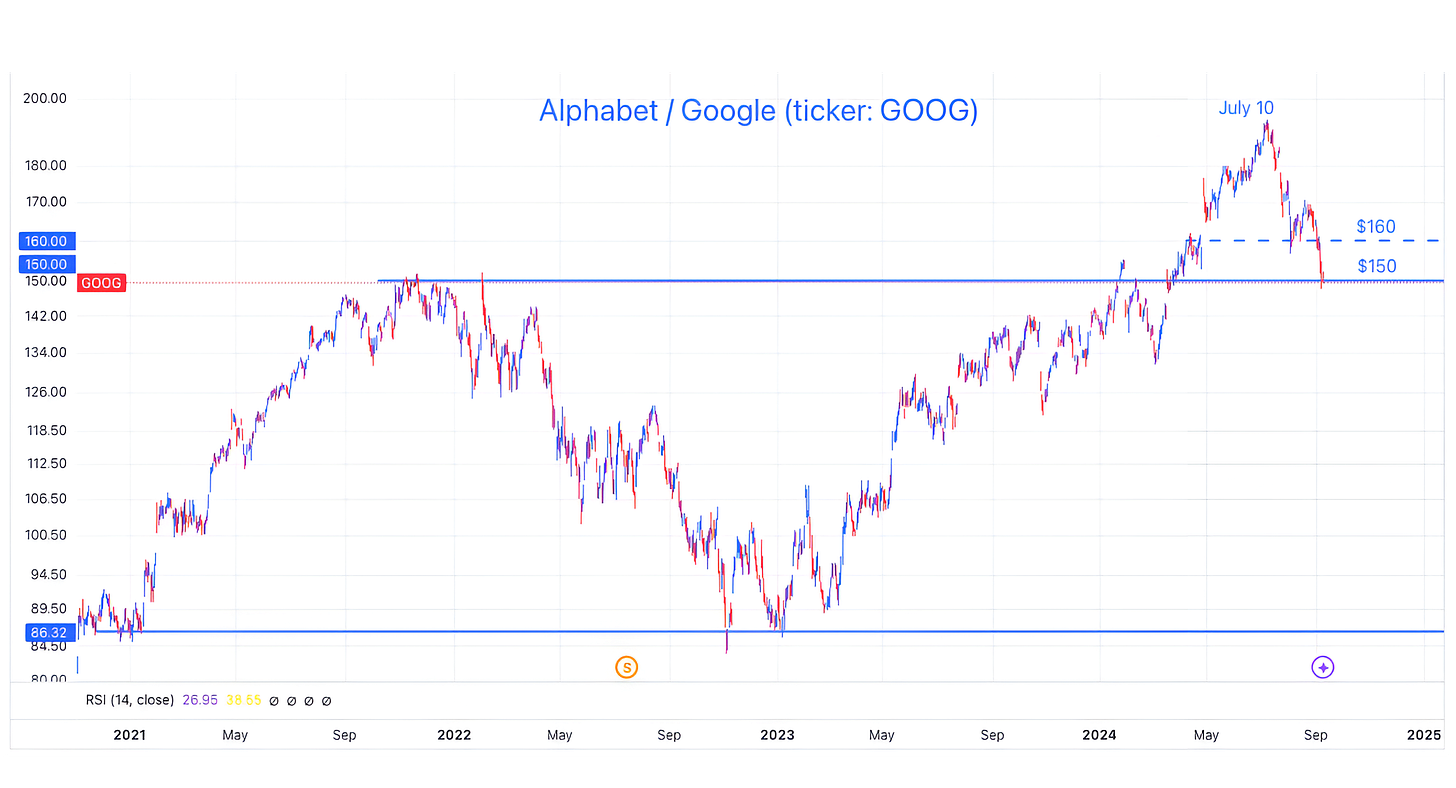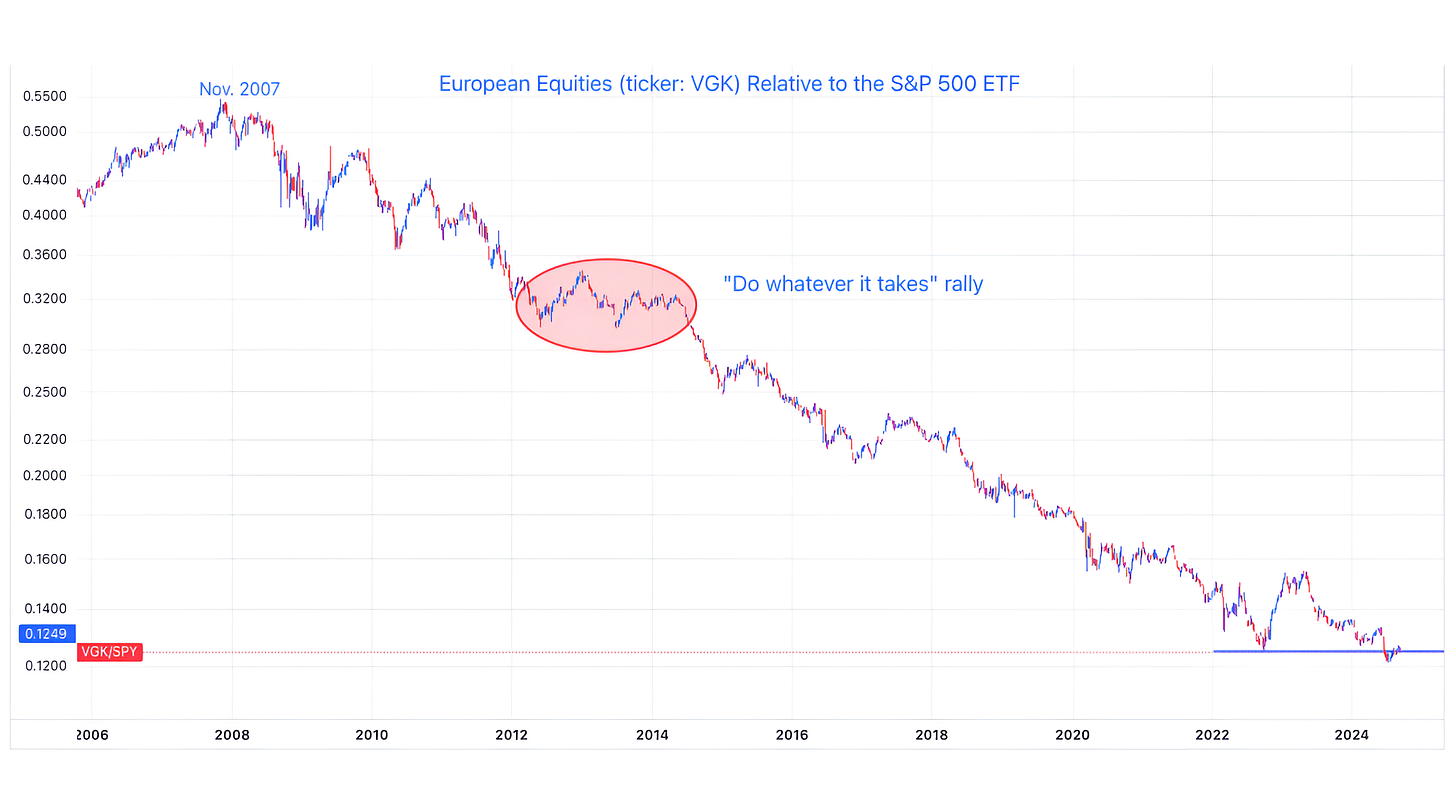Where Do We Go From Here?
The S&P 500 and Nasdaq 100 are in no-man's land. The debate over a US soft-landing vs. a recession continues. The Fed is expected to cut next week - will it be enough? Let's dig in...
Last week, I called the market “Livin’ on a Prayer.”
That was based on the combination of fundamental factors - a difficult macro, economic, and earnings environment with equities at a premium valuation - and technical indicators (charts) that had climbed back to all-time highs and looked as though they lacked the energy for further upside.
Since then, the S&P 500 dropped 8%.
While I still believe that a post-election rally (regardless of who wins) is likely, as I wrote at the beginning of June (here):
“We see the possibility (10-15% likelihood) of a 30% sell-off that would see the S&P 500 bottom around 4000-4200 in 2025 from a peak of 5500-5800 in 2024.”
Given some of the macro data we are watching (not only in the US but China); inflated 2025 US earnings expectations, elevated valuations and stretched sentiment (even the most consistent bears have capitulated), we believe the likelihood of a significant sell-off has increased to 20-30%.
Goldman Sachs does not agree with our view and their strategists recently stated that the U.S. stock market is unlikely to fall by 20% or more. They believe that the risk of a recession remains low given the expectation of the Fed's interest rate cuts (chart 2).
W will continue to watch the charts and data for indications of either outcome.
In terms of today’s song title, there are several songs by prominent artists titled “Where Do We Go From Here?”
Among the more notable songs using the title, there is the 1970 b-side from the band Chicago, Alicia Keys pondered the question in 2007, but my favorite is by “Where do We Go From Here? song is by Vanessa Williams from her 1996 movie with Arnold Schwarzenegger, Eraser.
1. The Nasdaq 100 May Be at a Level from Which it Can Bounce, but Will the Bounce Be Sustainable?
Source: Trading View. Through year-to-date 2024.
The chart above shows the Nasdaq 100 ETF (ticker: QQQ).
The last time we showed this chart (here) was nearly three weeks ago.
At the time, the Nasdaq 100 ETF was trading around $475 and we wrote:
“We believe that that odds for a pause and more likely a retracement of a portion of the recent rally are high.”
Since that time, the Nasdaq 100 has has come back down to the $445 level which marked the March high and is in the neighborhood of the ascending 200-day moving average.
While we believe a near-term bounce from this level is likely, we wouldn’t be surprised to see another visit to the $445 neighborhood. In our view, that will be the true battle.
Why is this our expectation?
In addition to the slowing earnings growth / high valuation story that we have highlighted, the Nasdaq 100 relative to the S&P 500 has now dropped below the line that we believed was important (we showed this here).
This relative weakness always concerns us as it can be a reflection of institutional investors rotating their portfolios away from the relative under-performer, in this case, the higher growth Nasdaq 100. These trends often continue (which is one reason why we show them).
Furthermore, when we look at charts of some of the largest components of the Nasdaq 100, including Apple, Nvidia, Google (chart 3 below) and Microsoft, they look fragile. This doesn’t mean that they’rr broken or that they will go down, it simply means that the charts are exhibiting weakness and they are levels that, in our view, look important.
(This is not a recommendation to buy or sell any security and is not investment advice. Please do your own research and due diligence).
2. Several US Rate Cuts are “Priced In.” Is the Market Seeing Economic Weakness or a Path to a Soft Landing?
Source: Bloomberg. Through year-to-date 2024.
The chart above shows the cumulative US rate cuts expected (priced in) by the market over the next year.
Traders are now expecting nearly 240 basis points (2.4%) of rate cuts through September 2025. This is nearly ten 25 basis point cuts.
The Fed has three meetings left this year and six more through (and including) September 2025.
This means that the market is currently expecting the Fed to cut rates at every meeting over the next year including one meeting where a 50% possibility of a 50 basis point cut has been priced in.
In our view, if the Fed needs to cut nine of ten times over the next 12 months it will due to a more significant economic slowdown than many are currently considering.
While there is some speculation that the Fed will cut 50 basis points next week, we do not believe it is currently likely.
This morning, Citigroup’s economics team announced that they expect the Fed to cut 1.25% over the rest of 2024.
In other words, Citi expects two 50 basis point cuts in the three remaining meetings this year. In our view, that would be the result of a significant economic slowdown. This path is more aggressive than we currently envision.
That said, last weeks employment report, specifically the revisions to the June and July data (once again lower), has many questioning the strength of the economy.
In addition, last week’s beige book report that highlights economic activity in different parts of the US reflected a slowdown:
“Economic activity grew slightly in three Districts, while the number of Districts that reported flat or declining activity rose from five in the prior period to nine in the current period.”
We have highlighted the deterioration of Consumer Discretionary relative to Consumer Staples (chart 2 here) and the strength in the Utilities sector (chart 3 here) as equity market signs of a slowdown.
While we continue to see several economic lights flashing yellow, we do not want to over-estimate red.
In our view, given recent data, the likelihood of a US recession has increased (~30%), but we do not want to be premature in predicting one.
This is a key reason we have increased the probability of an equity market sell-off.
(Past performance is not indicative of further results. This is not a recommendation to buy or sell any security and is not investment advice. Please do your own due diligence).
3. Google: On the Precipice
Source: Trading View. Through year-to-date 2024.
The chart above shows Alphabet (I still call it Google) shares.
This is not a recommendation to buy or sell Google.
About 10 years ago, I called Google a “desert island” stock.
I posed the hypothetical question that if you were going to a desert island for five years and couldn’t trade, what one stock would you want to own? My answer, at the time, was Google.
Why?
Google is the leader in multiple categories: search; browser; phone operating systems (Android is larger than Apple IOS globally); and driverless vehicles (Waymo). It remains one of the leaders in AI.
Perhaps, the most interesting division right now is Waymo, the autonomous vehicle division. Waymo (driverless cars) are available for rides and compete with Uber in Phoenix, Austin, Los Angeles and San Francisco. According to Morgan Stanley, this division is beginning to scale and deserves attention as a stand-alone entity.
Google is currently trading at about 18x earnings, which is a 10-year low.
However, when we look at the chart, shares are in a precarious position. As we characterized them above “fragile.”
That does not mean they have to go down. It simply looks like they’re at an important level while exhibiting weakness.
While, as we described above, many of the business dynamics appear favorable, shares may be depressed because of the unlimited spending requirements of AI with no clear economic benefit. (see Chart 4).
We have highlighted this challenge in the past and have likened it to when Facebook (it was Facebook back then) began spending uncontrollably on the metaverse. Shareholders did not like the zero return on investment use of free cash flow.
If the Nasdaq 100 begins to sell-off, led by the hyper-scalers (those spending $100s of billions on AI), the over-spending on AI without a clear profit goal will likely have been one of the reasons.
(Past performance is not indicative of future results. This is not a recommendation to buy or sell any security and is not investment advice. Please do your own due diligence).
4. Chat GPT: May Not Be the AI Killer App That We Thought It Was
Source: Goldman Sachs. Through year-to-date 2024.
The chart above shows the number of monthly visits (in millions) to Chat GPT.
While I like enhancing my thank you notes using Chat GPT as much as everyone else, it is clear that some of the novelty has worn off and this use seems like a limited revenue opportunity.
In my view, AI will likely follow the dot-com boom are mobile telecom evolutionary playbook.
What does that mean?
Although there was a lot of enthusiasm during the dot-com boom, more sophisticated investment and usage of the internet evolved over an extended time frame.
Many of the concepts created in the late 1990s - e-commerce, search, web enhanced home delivery, digital advertising and on-line news - required the dot-com bubble to burst and verticals rationalized before long-term winners began to emerge. It took time for the internet as we currently know it begin to form.
Similarly, it took several years for the most prominent apps on mobile telephones become apparent. Remember Farmville or Words With Friends?
Uber was founded 15 years ago; Facebook’s migration to the mobile platform was met with skepticism; and Spotify only began to replace Napster and iTunes after the launch of the iPhone.
While we know there will be incredible applications for AI - Larry Ellison, the founder of Oracle recently spoke about skin cancer detection - chat GPT in its current form, may not be it.
True commercial use may take time, while the investment needed will continue to be large.
There may be a reconciliation between investors that are seeking significant near-term returns and hyper-scalers that appear to be in an arms race.
As an aside, the illustration at the top of this letter “Where Do We Go From Here” was generated using AI. I don’t think that is that the killer app either.
(Past performance is not indicative of future results. This is not a recommendation to buy or sell any security and is not investment advice. Please do your own due diligence).
5. Could This Be Bullish for European Equities?
Source: Trading View. Through year-to-date 2024.
A year ago Ursula van der Leyen, President of the European Commission, asked Mario Draghi, the former head of the ECB, to prepare a report on the future of Europe’s competitiveness.
For those that don’t remember, in 2012, Mario Draghi, in a famous speech stated that, “Within our mandate, the ECB is ready to do whatever it takes to preserve the euro. And believe me, it will be enough.”
The “do whatever it takes” speech buoyed European equities and the Euro.
The European equity ETF (ticker: VGK) rallied 60% over the next two years. While it was not enough to outperform US equities over that period, it was the last extended period of equal performance between the two markets.
In 2012, markets listened to “Super” Mario and in my view, the European Union should listen to him now:
"Across different metrics, a wide gap in GDP has opened up between the EU and the US, driven mainly by a more pronounced slowdown in productivity growth in Europe. Europe’s households have paid the price in foregone living standards. On a per capita basis, real disposable income has grown almost twice as much in the US as in the EU since 2000."
"First – and most importantly – Europe must profoundly refocus its collective efforts on closing the innovation gap with the US and China, especially in advanced technologies. Europe is stuck in a static industrial structure with few new companies rising up to disrupt existing industries or develop new growth engines. In fact, there is no EU company with a market capitalisation over EUR 100 billion that has been set up from scratch in the last fifty years, while all six US companies with a valuation above EUR 1 trillion have been created in this period. This lack of dynamism is self-fulfilling."
"There are not enough academic institutions achieving top levels of excellence and the pipeline from innovation into commercialisation is weak.
[...] However, while the EU boasts a strong university system on average, not enough universities and research institutions are at the top. Using volume of publications in top academic science journals as an indicative metric, the EU has only three research institutions ranked among the top 50 globally, whereas the US has 21 and China 15."
"Regulatory barriers to scaling up are particularly onerous in the tech sector, especially for young companies. Regulatory barriers constrain growth in several ways. First, complex and costly procedures across fragmented national systems discourage inventors from filing Intellectual Property Rights (IPRs), hindering young companies from leveraging the Single Market. Second, the EU’s regulatory stance towards tech companies hampers innovation: the EU now has around 100 tech-focused laws and over 270 regulators active in digital networks across all Member States.
Many EU laws take a precautionary approach, dictating specific business practices ex ante to avert potential risks ex post. For example, the AI Act imposes additional regulatory requirements on general purpose AI models that exceed a pre-defined threshold of computational power – a threshold which some state-of-the-art models already exceed.
Third, digital companies are deterred from doing business across the EU via subsidiaries, as they face heterogeneous requirements, a proliferation of regulatory agencies and “gold plating” of EU legislation by national authorities. Fourth, limitations on data storing and processing create high compliance costs and hinder the creation of large, integrated data sets for training AI models.
This fragmentation puts EU companies at a disadvantage relative to the US, which relies on the private sector to build vast data sets, and China, which can leverage its central institutions for data aggregation. This problem is compounded by EU competition enforcement possibly inhibiting intra-industry cooperation. Finally, multiple different national rules in public procurement generate high ongoing costs for cloud providers.
The net effect of this burden of regulation is that only larger companies – which are often non-EU based – have the financial capacity and incentive to bear the costs of complying. Young innovative tech companies may choose not to operate in the EU at all."
If the EU can reduce regulation at a time when it is easing monetary policy, the valuation gap between US and European equities that is often cited as a reason for European equity outperformance might finally become meaningful.
Something to watch and consider after 17 years of US equity outperformance.
(Past performance is not indicative of future results. This is not a recommendation to buy or sell any security, please do your own research).









